1. Research Introduction
1.1 Research Background
This year, the market has sparked widespread discussion regarding VC tokens with high fully diluted valuations (FDV) but low circulating market capitalizations (MC). With the new tokens issued in 2024, the MC/FDV ratio has dropped to its lowest level in the past three years, indicating that a large number of tokens will be unlocked and enter the market in the future. Although the initial circulation is low, the market may experience a price increase in the short term due to rising demand, but this increase lacks sustainability. Once a large number of tokens are unlocked and enter the market, the risk of oversupply increases, leading investors to worry that this market structure may not provide lasting support for price increases.
As a result, many investors' interest has begun to shift from these VC tokens to Meme coins. Meme coins are characterized by most tokens being fully unlocked at the Token Generation Event (TGE), resulting in a higher circulation rate and no sell-off pressure from future unlocks. This structure reduces supply pressure in the market, giving investors more confidence. Many Meme coins have an MC/FDV ratio close to 1 at issuance, meaning holders will not face dilution from further token issuance, providing a relatively stable market environment. As awareness of the risks associated with large-scale token unlocks deepens, investor interest has gradually shifted towards these highly liquid, low-inflation Meme coins, even though these tokens may lack practical application scenarios.
In the current market landscape, investors are required to be more cautious in selecting tokens. However, when choosing tokens, investors often find it difficult to independently assess the value and potential of each project. At this point, the screening mechanism of exchanges becomes crucial. As the "gatekeepers" that directly push token assets to users, centralized exchanges not only help verify the compliance and market potential of tokens but also play a role in filtering quality projects. Although there is another voice in the market suggesting that on-chain transactions will surpass CEX transactions, Klein Labs believes that the market share of centralized exchanges will not be taken by on-chain transactions. Factors such as the smoothness of CEX transactions, centralized custodial asset management, the establishment of user habits and mindsets, liquidity barriers, and global regulatory compliance trends ensure that the trading share within CEX will long and consistently exceed that of on-chain transactions.
Thus, the ensuing question is, how do centralized exchanges filter and decide which projects to list? How have the coins listed in the past year performed overall? Is there a correlation between the performance of these listed tokens and the exchanges that selected them?
To address these market concerns, this study aims to explore the listing situations of major exchanges and analyze their actual impact on token market performance, focusing on changes in trading volume and price volatility characteristics after listing, in order to identify the influence of different exchanges on the market performance of listed tokens.
1.2 Research Methodology
1.2.1 Research Subjects
We categorize exchanges based on their geographical location and target market into three main types:
Chinese-founded, global focus: Binance, Bybit, OKX, Bitget, KuCoin, Gate, etc. These are well-known exchanges primarily founded by Chinese investors, targeting the global market. There are many Chinese exchanges, and for the sake of research, the selected exchanges have different developmental characteristics, while those not selected also have their own advantages.
Korean-founded, local focus: Bithumb, UPbit, etc. These primarily target the South Korean local market.
US-founded, targeting Europe and America: Coinbase, Kraken, etc. These are US exchanges mainly targeting the European and American markets, typically subject to strict regulation by the SEC, CFTC, etc.
Exchanges from other regions such as Latin America, India, and Africa are not analyzed in depth in this report due to their overall trading volume and liquidity being less than 5%.
We selected a total of 10 representative exchanges to analyze their listing performance, including the number of listing events and their subsequent market impact.
1.2.2 Time Frame
The study mainly focuses on price changes on the 1st day, the first 7 days, and the first 30 days after the token TGE, analyzing trends, volatility patterns, and market reactions for the following reasons:
- On the first day of TGE, new assets are issued, and trading volume is highly active, reflecting the market's immediate acceptance. It is significantly influenced by the rush to buy and FOMO emotions, making it a key stage for initial market pricing.
- The price changes in the first 7 days after TGE can capture the market's short-term sentiment towards the new token and the initial recognition of the project's fundamentals, measuring the sustainability of market enthusiasm and returning to the project's reasonable initial pricing.
- The first 30 days after TGE observe the long-term support of the token, as short-term speculation cools down, and speculators gradually exit. Whether the token price and trading volume are maintained becomes an important reference for market recognition.
1.2.3 Data Processing
This study employs a systematic data processing approach to ensure the scientific nature of the analysis. Compared to common research methods in the market, this study is more intuitive, concise, and efficient.
In this report, the data mainly comes from TradingView, covering price data of newly listed tokens on major exchanges in 2024, including initial listing prices, market prices at different time points, and trading volumes. Due to the large number of sample points, this large-scale data analysis helps reduce the impact of individual anomalous data on the overall trend, thereby improving the reliability of the statistical results.
(I) Multivariable Overview of Listing Activities
This study employs a multivariable analysis method, considering factors such as market conditions, trading depth, and liquidity to ensure the comprehensiveness and scientific nature of the results. We compared the average price fluctuations of new tokens across different exchanges and conducted in-depth analysis in conjunction with the exchanges' market positioning (such as user base, liquidity, and listing strategies).
(II) Average Value to Assess Overall Performance
To measure the market performance of tokens, we calculated the percentage change relative to the initial listing price, using the following formula:

Considering that extreme situations in the market may affect the overall data trend, we excluded the top 10% and bottom 10% of extreme outliers to reduce the interference of sporadic market events (such as sudden positive news, market manipulation, and liquidity anomalies) on the statistical results. This processing method makes the calculation results more representative and can more accurately reflect the true market performance of new tokens across different exchanges. Subsequently, we calculated the average price fluctuations of new tokens on each exchange to assess the overall performance of new tokens in different platforms.
(III) Coefficient of Variation to Assess Stability
The Coefficient of Variation (CV) is an indicator of relative volatility in data, calculated using the formula:

Where σ is the standard deviation and μ is the mean. The coefficient of variation is a dimensionless indicator, unaffected by data units, making it suitable for comparing the volatility of different datasets. In market analysis, CV is mainly used to measure the relative volatility of prices or returns. In the analysis of exchange or token prices, CV can reflect the relative stability of different markets, providing investors with a basis for risk assessment. Here, we use the coefficient of variation instead of standard deviation because the coefficient of variation has higher applicability compared to standard deviation.
2. Overview of Listing Activities
2.1 Comparison Between Exchanges
2.1.1 Number of Listings and FDV Preferences
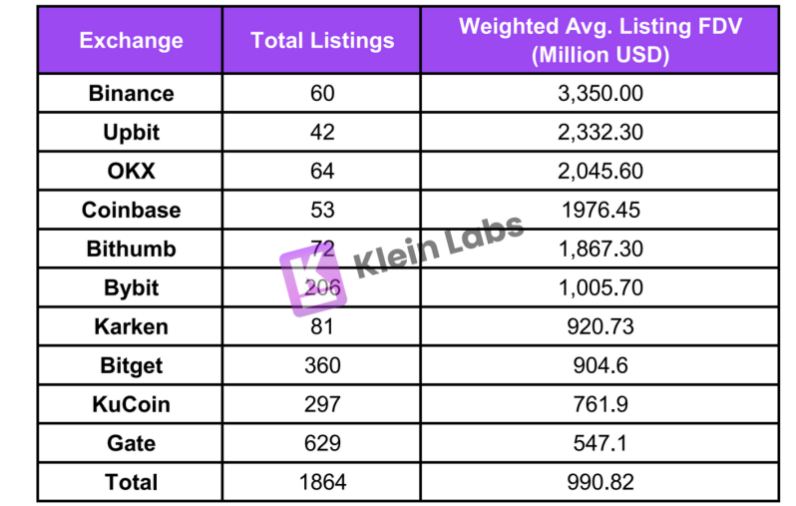
Overview of Listing Events in 2024
We found that, overall, top exchanges (such as Binance, UPbit, Coinbase) generally have fewer listings compared to other exchanges. This reflects how the position of the exchange influences its listing style.
In terms of the number of listings, exchanges like Binance, OKX, UPbit, and Coinbase have stricter listing rules, resulting in fewer but larger-scale listings; whereas exchanges like Gate list new assets more frequently, providing more trading opportunities. The data shows that the number of listings is roughly negatively correlated with FDV, meaning exchanges that list more high FDV projects typically have fewer listings.
CEXs adopt different strategies to determine listing priorities, focusing on different levels of fully diluted valuation (FDV). Here, we categorize projects based on their FDV to better understand the listing standards of exchanges. When valuing tokens, we often consider both MC and FDV, as they together reflect the valuation, market size, and liquidity of the token.
- MC only calculates the total value of currently circulating tokens, not considering future unlocked tokens, which may underestimate the true valuation of the project, especially when most tokens have not yet been unlocked, leading to potential misguidance.
- FDV is calculated based on the total supply of tokens, providing a more comprehensive reflection of the project's potential valuation, helping investors assess future sell-off risks and long-term value. For projects with low MC/FDV, the short-term reference significance of FDV is limited, serving more as a long-term reference.
Therefore, when analyzing newly listed tokens, FDV is more relevant than Market Cap. Here, we choose FDV as the standard.
Additionally, regarding the attitude towards initial projects, most exchanges typically adopt a balanced strategy, considering both initial and non-initial projects, but usually have higher requirements for non-initial projects, as initial projects tend to bring in more new users. Furthermore, the two Korean exchanges, UPbit and Bithumb, mainly focus on non-initial listings. This is because, compared to initial listings, non-initial listings can reduce selection risks and avoid market volatility and initial liquidity issues during the initial phase. At the same time, for project teams, compared to initial listings, they do not need to bear excessive market promotion and liquidity management pressure, as non-initial listings can leverage existing market recognition to drive growth.
2.1.2 Track Preferences
- Binance
In 2024, the number of Meme coins still accounts for the largest share. Infra and DeFi projects also have a significant proportion. The RWA and DePIN tracks have relatively fewer listings on Binance but perform well overall. Among them, the highest increase for USUAL spot reached 7081%. Although Binance is cautious in its listing choices in these areas, once listed, the market response is usually positive. In the second half of the year, Binance's listing preference in the AI track clearly tilted towards AI Agent tokens, which accounted for the highest proportion among AI projects.
In 2024, Binance shows a preference for the BNB ecosystem. For example, the listings of projects like BANANA and CGPT indicate Binance's strengthening support for its own on-chain ecosystem.
- OKX
The number of listings on OKX also shows that Meme coins account for the largest share, approximately 25%. In comparison to other exchanges, OKX has more listings in the public chain and infrastructure tracks, totaling up to 34%. This indicates that OKX is more focused on underlying technological innovation, scalability optimization, and the sustainable development of the blockchain ecosystem in 2024.
In emerging tracks, OKX has only listed four AI tokens, including DMAIL and GPT, and three new tokens in the RWA track, with only three in the DePIN track. This reflects OKX's cautious approach to its layout in relatively emerging tracks.
- UPbit
The most significant feature of UPbit's listings in 2024 is its broad coverage of tracks, with tokens generally performing well. In 2024, UPbit listed UNI and BNT in the DEX track. This indicates that UPbit still has considerable potential and room for development in listing popular assets, as many mainstream or high market cap tokens have yet to be listed, suggesting future expansion of support. At the same time, this also reflects UPbit's strict review process for listings, showing a preference for carefully selecting assets with long-term potential.
At UPbit, the price increases of tokens across various tracks are quite prominent. Tokens from tracks such as PEPE (Meme), AGLD (Game), DRIFT (DeFi), and SAFE (Infra) have seen significant short-term increases, with some exceeding 100% or even 150%. UNI's price increased by as much as 93.5% after 30 days compared to its first day. This reflects the high recognition of UPbit's listed projects among Korean users.
Additionally, from the perspective of public chain ecosystems, public chains like Solana and TON are quite favored. We also observe that exchanges are gradually deepening their support for their own blockchain ecosystems. For example, Binance's associated BSC and opBNB chains have continuously strengthened their support for their own on-chain ecosystems. Similarly, Coinbase's Base has also become a key focus of support, accounting for nearly 40% of all newly listed tokens in 2024. OKX has also been making continuous efforts in the X Layer ecosystem layout. Furthermore, Kraken's planned launch of the L2 network Ink further indicates that leading exchanges are actively promoting the construction of on-chain infrastructure.
Behind this trend is the exploration of exchanges transitioning from "off-chain" to "on-chain," which not only expands their business scope but also strengthens their competitiveness in the DeFi field. By supporting projects on their own chains, exchanges can not only promote ecosystem development but also enhance user stickiness and achieve higher returns in the issuance and trading of new assets. This also means that in the future, exchanges' listing strategies will increasingly favor projects within their own ecosystem to enhance the activity and market influence of their blockchain networks.
2.2 Time Dimension Analysis

Monthly listing numbers for different exchanges
- The trend of the number of listing events is highly consistent with the rise and fall of BTC prices. During BTC's upward periods (February to March and August to December), there were more listing events, while during BTC's sideways or downward periods (April to July), the number of listing events significantly decreased.
- The listing activities of top exchanges (Binance, UPbit) are less affected during bear markets, and their share of listings actually expanded during this period, demonstrating stronger market dominance and anti-cyclical capabilities.
- Bitget's number of listings remains stable, with market fluctuations having little impact on it, while other exchanges experience greater volatility in their listing rhythms. This may be related to its more balanced listing strategy.
- Gate and KuCoin have higher listing frequencies, but the number of listings fluctuates significantly with market conditions, indicating that these exchanges may rely more on the higher liquidity of new projects during bull markets to attract users.
3. Trading Volume Analysis
3.1 Overall Trading Volume Situation of Different Exchanges
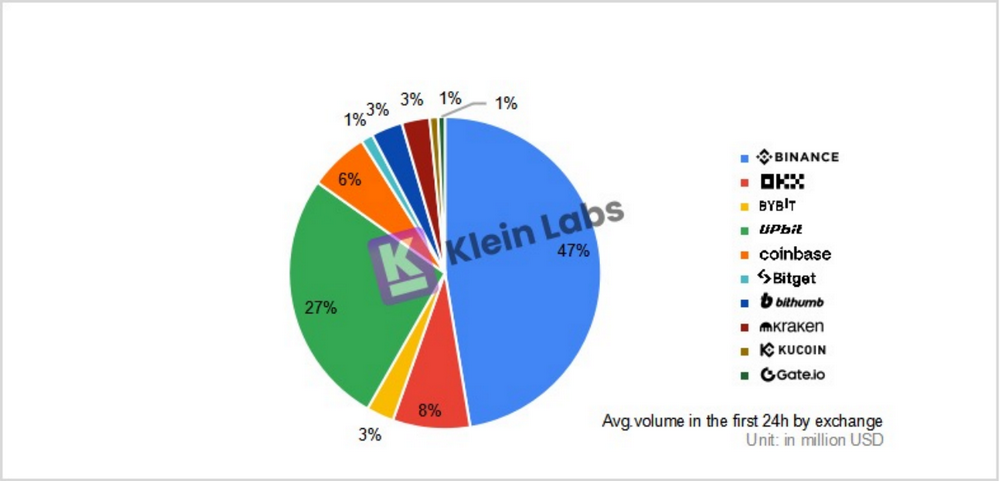
Average trading volume of projects 24 hours after TGE on various exchanges in 2024
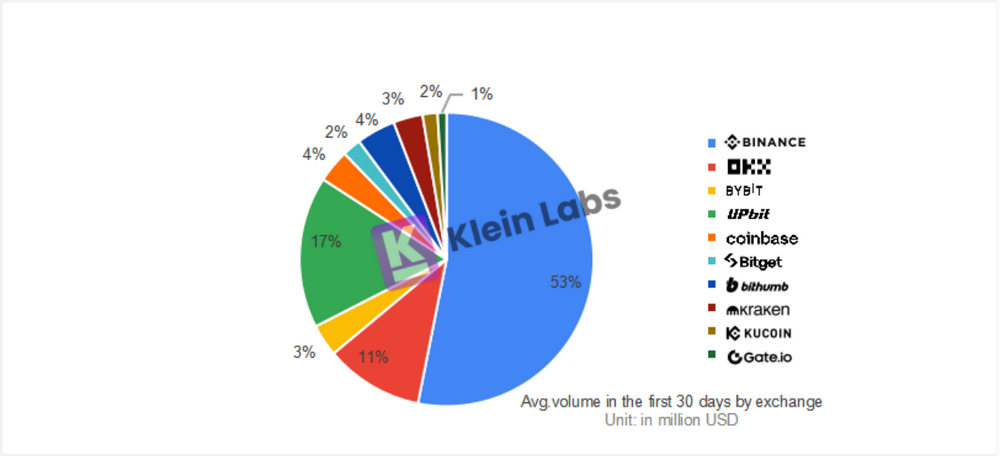
Average trading volume of projects 30 days after TGE on various exchanges in 2024
- UPbit has a very high trading volume proportion within 24 hours of a token's listing, even exceeding half of Binance's, demonstrating its strong short-term market appeal and significant liquidity influx. Although the proportion slightly decreases after 30 days, it still maintains a high market share, approaching the combined share of the three top exchanges: OKX, Coinbase, and Bybit, indicating UPbit's extremely important position in the listing market.
- Binance and OKX show steady growth in trading volume, with their market shares still leading after 30 days, reflecting strong market recognition and liquidity depth. Binance accounted for 47% within 24 hours, increasing to 53% after 30 days, indicating its long-term market dominance, while OKX also maintained a high share after 30 days.
- Bybit performs well in both short-term and long-term trading volumes, remaining relatively stable. Meanwhile, Bithumb's market share slightly increased after 30 days, indicating that it can not only retain early trading volume but also attract more liquidity. This suggests that Bithumb's competitiveness in the listing market has strengthened.
Although Korean exchanges are known for their preference for non-initial projects, as the above data shows, these projects can still generate very strong trading volumes. The core reason for the substantial trading volume of non-initial projects on Korean exchanges lies in their unique market environment:
The Closed Nature and Concentrated Liquidity of the Korean Trading Market
- Market Closure: Due to strict KYC policies in South Korea, overseas users are generally unable to directly use Korean exchanges, leading to a relatively closed trading ecosystem in the Korean market; a large number of local users are accustomed to trading on Korean exchanges. Therefore, liquidity within the Korean market is more concentrated.
- Exchange Monopoly: The Korean crypto market exhibits a highly monopolized structure, with UPbit currently holding 70%-80% of the Korean crypto market share, firmly establishing itself as the industry leader. After UPbit established its leading position in 2021, Bithumb's previous top position was replaced, and its market share fell to 15%-20%. Trading volume and liquidity in Korea are concentrated on leading platforms, demonstrating a strong capital aggregation effect.
Thus, even if a token is not being listed for the first time in the global market, its trading situation in the Korean market can still exhibit a "first listing" effect, attracting significant market attention and capital inflow.
High Holding Rate and Capital Advantages in the Korean Crypto Market
- High Penetration of Crypto Assets: The proportion of South Korean investors holding cryptocurrencies is extremely high, far exceeding that of other major markets. As of November 2024, the number of people holding cryptocurrencies on Korean exchanges exceeds 15.59 million, accounting for over 30% of South Korea's total population. Many South Koreans already hold a large amount of crypto assets and tend to prefer digital assets in their investment choices. With only 0.6% of the global population, South Korea contributes 30% of the global cryptocurrency trading volume.
- Abundant Social Capital: Additionally, South Korea is a developed country with a high GDP, and overall social capital is relatively abundant, providing a large amount of investable funds, which gives the crypto market ample liquidity.
- Limited Survival Space for Young People in Traditional Industries: South Korea is a capitalist country dominated by chaebols, and young people face significant employment and living pressures, with class solidification intensifying the demand for wealth appreciation channels. Approximately 3.08 million young people aged 20-39 participate in virtual currency trading, accounting for 23% of the total population in that age group.
As of November 2024, the total holding of cryptocurrencies by the South Korean public has increased to 102.6 trillion won (approximately 6.9768 billion USD), with the average daily trading volume climbing to 14.9 trillion won (approximately 1.0132 billion USD). UPbit became the fastest-growing CEX in trading volume in the fourth quarter of 2024, increasing from 135.5 billion USD to 561.9 billion USD, a quarter-on-quarter growth of 314.8%. This growth reflects the strong demand for crypto assets in the Korean market and further corroborates the high trading volume trend of non-initial projects on Korean exchanges.
4. Price Performance Analysis
4.1 Price Performance Comparison by Exchange
4.1.1 Overall Price Performance of Listings on Each Exchange
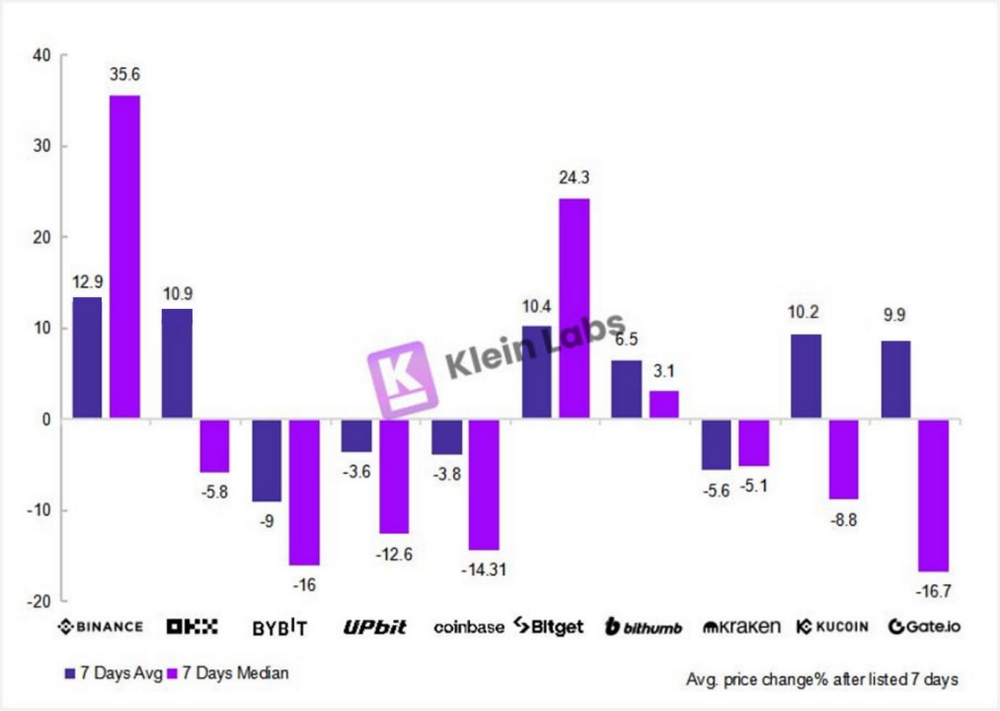
Comparison of average and median trading volume prices for each exchange 7 days after TGE
- Binance performs the best, with both average and median values being quite prominent. The top three in average values are Binance, OKX, and Bitget, where OKX has a positive average but a negative median, indicating significant price volatility for rising tokens, with sharp price fluctuations in the short term and noticeable outliers. Bitget performs relatively well, being the closest among other exchanges to the two leading exchanges. Additionally, its median increase ranks second among all exchanges, only behind Binance, and shows a high positive value, indicating a strong and positive upward trend in token prices on Bitget.
- Among mid-sized exchanges, Bithumb, Gate, and KuCoin perform relatively well. Bithumb is the most balanced in price performance, with the smallest difference between absolute value and median, indicating low price volatility and stable performance. However, both KuCoin and Gate have negative medians with relatively high absolute values, suggesting a lower win rate for tokens and the potential presence of many upward outliers interfering with the results.
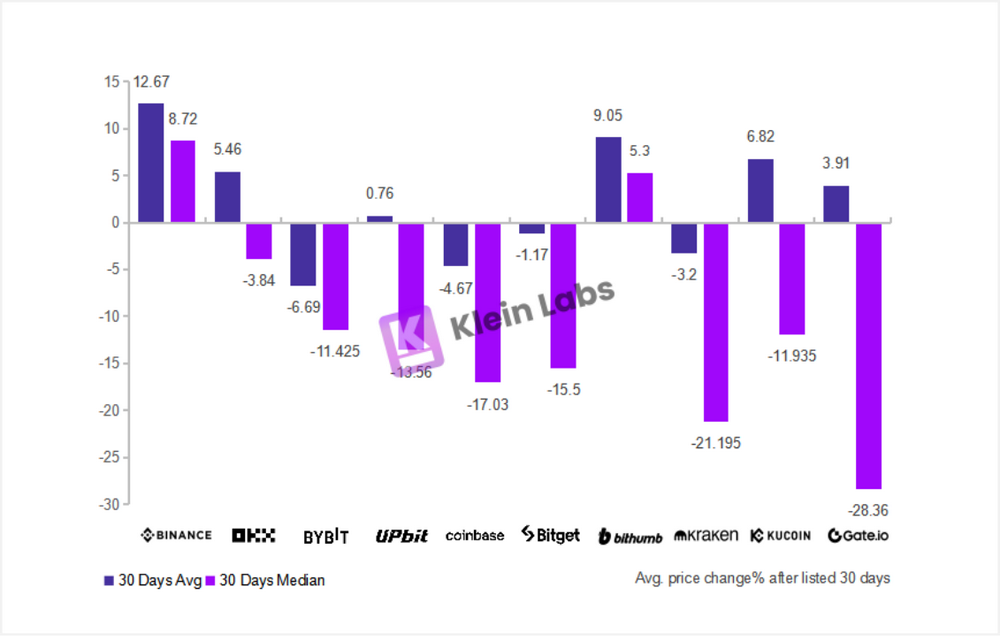
Comparison of average and median trading volume prices for each exchange 30 days after TGE
- By Day 30, the overall median has dropped, indicating that after 30 days, especially for tokens with lower liquidity, a portion of speculative funds has withdrawn from the market, increasing selling pressure and insufficient buying support, leading to price declines. Gate may have experienced significant market fluctuations due to an excessive number of new listings, resulting in insufficient liquidity. This suggests that the platform has failed to attract enough stable capital inflow, and the abundance of token choices has diluted liquidity, disrupting the balance between buyers and sellers, causing substantial price drops.
- Binance is less affected, with a slight decrease in average values, indicating that its listed tokens still maintain strong market support and stable trading volumes after 30 days, with some tokens still having room for price increases. As a top exchange, Binance benefits from its vast market liquidity and extensive user base, allowing its token prices to remain at a high level even when the overall new token market declines after 30 days.
- Among mid-sized exchanges, Bithumb is the only one that has increased after 30 days, with both the 7-day increase and median being positive. This indicates that Bithumb has successfully attracted funds due to its good market liquidity and stability, demonstrating strong resilience and market appeal. This may be because Bithumb's lower number of listings allows it to concentrate liquidity, maintaining strong market activity, enabling newly listed tokens to perform better in terms of price.
4.1.2 Monthly Price Performance of Each Exchange
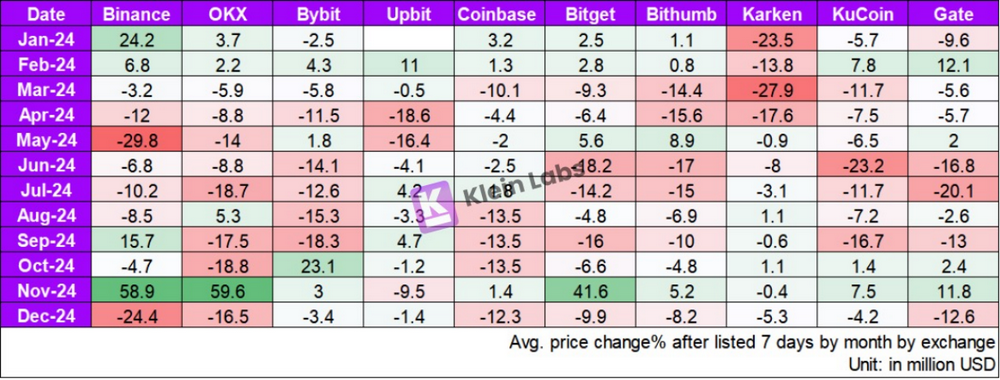
Price changes for each exchange one week after TGE each month
- Binance and UPbit show significant price advantages, heavily influenced by market sentiment. The listings on Binance and UPbit perform exceptionally well during favorable market conditions; for example, in May and September, Binance's 30-day increases reached 87.8% and 94.9%, respectively, while UPbit also saw a 60.5% increase in September, demonstrating strong price advantages but with high volatility, showing significant declines in April and July, indicating a strong impact of market sentiment.
- The overall market conditions significantly affect token trends, with top exchanges experiencing larger increases during bull markets, while mid-sized exchanges are more prone to significant declines during market downturns. For instance, Bybit and OKX saw 30-day declines of -40.6% and -36.6% in July, respectively, while Kraken and KuCoin also performed weakly after 7 days, particularly with Kraken experiencing declines of -23.5% and -27.9% in January and March, respectively.
4.2 Volatility of Price Changes
In the previous section, we reflected the overall price changes using average values. Next, we will use the coefficient of variation to reflect the volatility of sample data around the average price changes. A smaller coefficient of variation indicates that the data distribution is more concentrated, with most tokens' price changes close to the average level, suggesting a more stable market and stronger predictability of price fluctuations after listings; conversely, a larger coefficient indicates greater uncertainty in price trends after listings.
Next, we will analyze the prices on Day 1 and Day 30 separately:
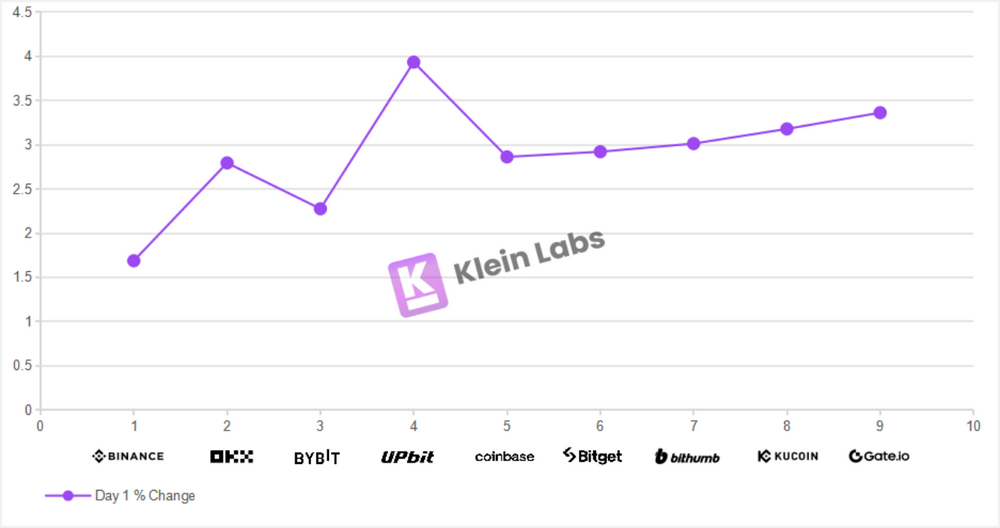
Changes in the coefficient of variation on Day 1 after TGE
- Binance has the lowest coefficient of variation, indicating that the price fluctuations of its listed tokens on the first day are relatively small, making its market performance the most stable. UPbit has the highest coefficient of variation, showing significant fluctuations on the first day, but combined with previous average value analysis, it is estimated that its market is likely to show a general upward trend.
- Among mid-sized exchanges (from left to right along the axis), the coefficient of variation shows a linear increasing trend, from the lowest at Bitget to the highest at Gate. This indicates that the market performance of these exchanges' listings is gradually shifting from relatively stable to higher uncertainty, with short-term investment risks increasing.
- Bybit has a relatively low coefficient of variation, closest to Binance, indicating that its market volatility is also relatively controllable. However, considering that Bybit has a large number of listings, it still maintains a low coefficient of variation, suggesting that the overall quality of its listed projects is high, with no large-scale high-volatility tokens. Additionally, this reflects that Bybit's listing selection strategy may lean towards more stable tokens, thereby reducing the risk of severe market fluctuations in the short term.
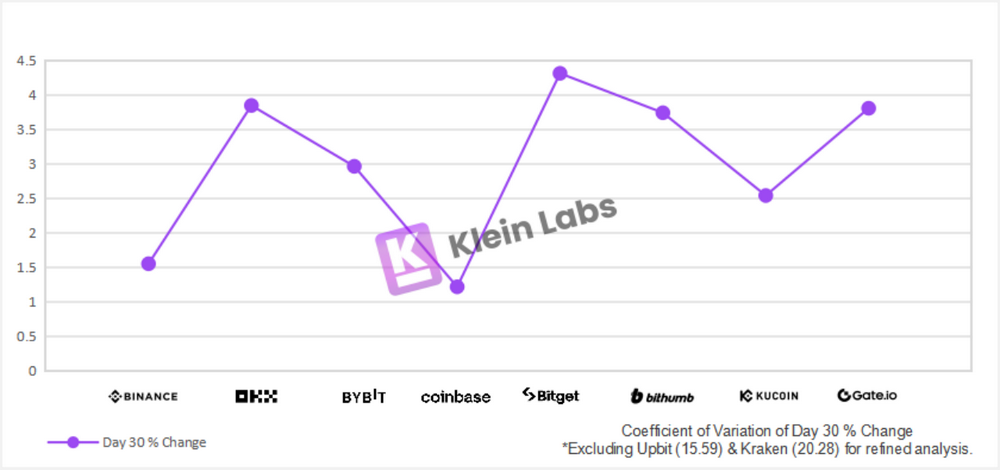
Changes in the coefficient of variation on Day 30 after TGE
- From the Day 30 coefficient of variation, UPbit maintains a high coefficient of variation even after 7 days and 30 days, indicating significant price fluctuations in its trading pairs and high market liquidity. Observing the average values, UPbit's average is positive, and the price decline is relatively slow, suggesting that market buying and selling are quite active, with strong liquidity depth, indicating overall market health. From the perspective of the coefficient of variation, UPbit has a significant advantage over other exchanges in this regard.
- Binance and Coinbase remain relatively stable exchanges, with Binance showing stable increases throughout the period, while Coinbase's fluctuations tend to stabilize between 7 days and 30 days, indicating that its token market is more inclined towards long-term steady development rather than short-term volatility.
- Mid-sized exchanges (such as Bitget, Bithumb, Gate, KuCoin) see a significant increase in the coefficient of variation on Day 30, indicating that after short-term arbitrage funds withdraw, liquidity decreases, leading to increased price volatility. The market is still dominated by short-term funds, with a low proportion of long-term funds, resulting in overall weaker stability. Particularly, Bitget shows high activity but greater volatility risk.
5. Highlights Summary
5.1 Data Conclusions
Based on the above research and data, we draw the following conclusions:
1. The choice of exchanges for listings significantly affects listing performance.
Generally, exchanges with fewer listings and stricter criteria tend to show better price performance after removing extreme outliers. However, the overall Bitcoin trend, regional market environment, and user characteristics also influence listing performance.
Exchanges with a larger number of listings do indeed stand out in short-term average performance, but in the long term, the abundance of listings can lead to more diluted liquidity, potentially resulting in greater declines after 30 days and lower price stability.
2. Top exchanges often have a greater increase advantage compared to mid-sized exchanges during favorable market conditions.
However, from another metric, the average increase shows that major top exchanges exhibit varying performance in increases over 7 days and 30 days, but overall remain positive. Binance provides the best feedback across all price indicators. OKX shows significant volatility in the medium to long term. Among top exchanges, UPbit's performance is the most stable, likely due to its deep liquidity. Additionally, UPbit can achieve extremely high price fluctuations within the first day of token listings. However, since this study records the final closing price on the first day, it may not capture these outstanding performances. Among mid-sized exchanges, Bitget and Bithumb perform notably well, with Bitget showing stability and Bithumb excelling in certain price indicators.
3. Advantages of the Korean market and listing effects.
The Korean market has a unique environment, with high trading volumes and good liquidity, allowing tokens to quickly attract capital after listings. Although initial price fluctuations can be significant, the overall trend is upward. Moreover, price fluctuations remain intense after 7 days and 30 days, indicating that tokens listed in the Korean market will receive longer development cycles and higher attention.
4. The impact of exchange selection processes on token performance and market stability.
During data processing, we found that certain exchanges have significantly more outliers, indicating that the token selection and review processes are crucial for post-listing performance. Outliers typically reflect token prices deviating from expectations, potentially influenced by market manipulation or project risks. Exchanges that frequently experience outliers may have more lenient selection processes, allowing unstable tokens to enter the market, increasing the risk of price volatility. Therefore, the token selection processes of exchanges directly impact the market performance of tokens and overall market stability.
5.2 Exchange Performance
Binance & OKX
Both perform excellently across various indicators, but in the long term, Binance has a greater advantage in stability. Binance's market performance is relatively stable, maintaining continuous growth with low volatility. In contrast, while OKX exhibits greater market volatility than Binance, it is nearly comparable to Binance across multiple indicators.
Upbit & Bithumb
Upbit and Bithumb are the two leading cryptocurrency exchanges in South Korea, showing overall strong performance. Upbit consistently ranks high among global exchanges. Bithumb, as one of the earliest exchanges established in South Korea, performs exceptionally well with certain tokens. The high enthusiasm for trading in the Korean market has led to a significant influx of capital into local exchanges, resulting in high liquidity and trading volumes. Due to deep liquidity and a large number of retail investors in South Korea, price changes are not very pronounced on a medium to long-term scale. However, focusing on shorter-term hourly trading, the trading volume and price volatility of Korean exchanges exceed those of other exchanges at the same level. Since this study primarily examines price changes on Day 1, 7, and 30 after token listings, it may not fully reflect the outstanding performance of Korean exchanges.
It is worth noting that Upbit and Bithumb have a clear "kimchi premium" regional advantage. Certain tokens listed on Korean exchanges often see prices rise above those on other global exchanges shortly after listing, providing Upbit and Bithumb with an unmatched advantage compared to other exchanges worldwide.
Bybit
As one of the top exchanges, Bybit possesses strong liquidity depth and extensive listing experience, providing a stable trading environment. Despite experiencing a significant theft incident in early 2025, Bybit demonstrated its capability as a large exchange through timely and effective public relations handling and security measures. In contrast, many smaller exchanges often lack the ability to respond to such challenges. Bybit's risk management and public relations strategies are also well-executed, especially in maintaining sufficient financial resources, quickly restoring user trust, and continuing to maintain its competitiveness in the market.
Bitget
Among mid-sized exchanges, Bitget stands out with rapid development. Bitget is in a transformation phase towards becoming a top-tier exchange, leaning towards implementing stricter listing mechanisms. The platform has launched a considerable number of new tokens, providing investors with a broader selection. Additionally, based on average data, the overall performance of listed tokens is quite good, and the positive price fluctuations of these tokens significantly exceed those of similar-tier platforms. The preference for quality projects on Bitget is gradually becoming evident, as the platform maintains a cautious approach to project selection and achieves more precise selection through a dual-incentive mechanism. Overall, Bitget's market performance lies between that of top-tier exchanges and the average level of mid-sized exchanges, demonstrating good price performance and market recognition. Compared to similar exchanges, the price fluctuations of tokens on Bitget are relatively stable, showing high resilience during market volatility, thereby maintaining strong market competitiveness and user trust.
Gate
Gate is rapidly rising. With a high proportion of new listings and continuously innovative listing strategies, Gate's data performance in 2024 is impressive, with trading volumes gradually increasing and noticeable token price increases. Gate has successfully attracted a large number of emerging projects, significantly enhancing its market competitiveness and continuously expanding its influence in the crypto market. Gate has excelled in the meme sector and has established an innovation zone to provide dedicated sections for newly listed tokens. With keen market insights, it has successfully launched multiple popular tokens, attracting a large number of investors. Its innovative listing strategies and precise project selection have helped the platform quickly expand its ecosystem, enhancing user stickiness and promoting growth in trading volume and liquidity.
KuCoin
Beyond the focus of this report on new listings, KuCoin has made significant progress in compliance. KuCoin has reached a settlement with the U.S. Department of Justice (DOJ), paving the way for the future development of KuCoin and its new leadership team. KuCoin is also actively obtaining relevant licenses, particularly in Australia and India, while also making strides in Europe and Turkey. KuCoin is applying for a license compliant with the Markets in Crypto-Assets Regulation (MiCAR) through KuCoin EU Exchange GmbH in Austria. Additionally, KuCoin is the first global cryptocurrency exchange in India to comply with the Financial Intelligence Unit (FIU) regulations. By promoting compliance and regional expansion, KuCoin is expected to attract more potential users, boost trading volume and price growth, creating favorable conditions for its continued growth in the future.
Coinbase & Kraken
As the largest exchange in the U.S., Coinbase possesses strong liquidity and a deep market. Coinbase's cautious listing strategy, combined with the relatively strict cryptocurrency regulatory policies in the U.S., results in a relatively low number of listings on the platform, but it also offers high security and stability. This indicates that Coinbase adopts a conservative listing strategy for new projects, especially high-risk assets like meme coins. However, in terms of price performance, while it chooses to pursue stability and long-term development, it has also missed out on many upward opportunities. Kraken is known for its security and is subject to strict regulations, resulting in fewer product services compared to other exchanges.
6. References
- Animoca Brands Research on 2024 Listing Report
https://research.animocabrands.com/post/cm71o17u2t6f107mlc6v09ujq
- Low Float & High FDV: How Did We Get Here?
https://www.binance.com/en/research/analysis/low-float-and-high-FDV-how-did-we-get-here
- CoinGecko 2024 Annual Crypto Industry Report
https://www.coingecko.com/research/publications/2024-annual-crypto-report
- Domestic Coin Exchange Total Investors Surpass 15 Million for the First Time… 600,000 Increase in November
https://www.yna.co.kr/view/AKR20241224079900002
免责声明:本文章仅代表作者个人观点,不代表本平台的立场和观点。本文章仅供信息分享,不构成对任何人的任何投资建议。用户与作者之间的任何争议,与本平台无关。如网页中刊载的文章或图片涉及侵权,请提供相关的权利证明和身份证明发送邮件到support@aicoin.com,本平台相关工作人员将会进行核查。




